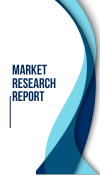
Androgen Replacement Therapy Market - Global Industry, Analysis, Size, Share, Growth, Trends, and Forecasts 2023-2030
- Category: Healthcare
- Report ID: CMR14963
- Upcoming
Androgen replacement therapy, often referred to as testosterone replacement therapy is a form of hormone therapy in which androgens, often testosterone, are supplemented or replaced. It typically involves the administration of testosterone through injection, skin creams, patches, gels, pills, or subcutaneous pellets. Androgen replacement therapy is often prescribed to counter the effects of male hypogonadism. Androgen deficiencies in women have also, as of 2001, been recognized as a medical disorder that can be treated with androgen replacement therapy. As with men, symptoms associated with androgen deficiency are, most prevalent with age, and androgen replacement therapy has been shown to help with symptoms of menopause.
Androgen replacement is used in postmenopausal women, the indication is to increase sexual desire and to prevent or treat osteoporosis. Other symptoms of androgen deficiency are similar in both sexes, such as muscle loss and physical fatigue. For two decades transdermal testosterone preparation has been available and has an attractive pharmacokinetic profile. Scrotal testosterone patches generate supraphysiological plasma DHT levels, which is not the case with nonscrotal testosterone patches. Transdermal testosterone gel produces less skin irritation than the patches and offers greater flexibility in dosage. Clinicians need to prescribe androgen replacement therapy by using a risk-benefit assessment of individual patient’s clinical needs and risk of adverse reaction. Clinical use of androgen replacement therapy for the treatment of senile hypogonadism is growing rapidly. Such widespread application of this treatment modality warrants a critical review of both its purported benefits and its potential risks.
Global Androgen Replacement Therapy Market – Competitive Landscape
On November 14, 2022, MBX Bioscience secured USD 115 million to advance precision endocrine peptides. On October 27, 2022, Tolmar announced the acquisition of JATENZO® for the treatment of hypogonadism to expand its market-leading urology portfolio. On August 24, 2022, Plume, a startup focused on virtual care for transgender patients raised USD 24 million in series B funding. On April 6, 2022, Evernow, a telehealth company dedicated to using science to transform care for women in perimenopause and menopause announced USD 28.5 million in series A funding.
Some of the Key Players in the Global Androgen Replacement Therapy Market Include –
- AbbVie Inc.
- Endo Pharmaceutical Inc.
- Pfizer
- Eli Lilly and Company
- Allergan Plc.
- Bayer AG
- Mylan N.V.
- Ferring Holding SA
Global Androgen Replacement Therapy Market – Growth Drivers
As the global population ages, there’s a higher incidence of age-related hormonal imbalances particularly in men, driving the demand for androgen replacement therapy. Growing awareness among both healthcare professionals and the general population regarding hormonal disorders, such as hypogonadism, contributes to an increased diagnosis and subsequent treatment with androgen replacement therapy. The rising prevalence of hypogonadism, a condition characterized by inadequate testosterone production, is a significant factor fueling the demand for androgen replacement therapy. According to the National Center for Biotechnology Information (NCBI), the crude prevalence rate of hypogonadism was 38.7%. for every 10-year increase in age, a patient’s risk of hypogonadism increased by 17%. Ongoing advancements in medical technology including the development of innovative and more effective therapeutic formulations, enhance the efficiency and acceptance of androgen replacement therapies. Modern sedentary lifestyles and environmental factors contribute to hormonal imbalances, fostering the need for androgen replacement therapy to address related health issues. The introduction of diverse androgen replacement therapy options, such as patches, gels, injections, and implants, provides patients with choices, contributing to global androgen replacement therapy market expansion.
Global Androgen Replacement Therapy Market – Restraints
Concerns regarding potential side effects and the long-term safety of androgen replacement therapy, including cardiovascular risk and prostate-related issues, can limit widespread acceptance and usage. Regulatory scrutiny and stringent approval processes for new androgen replacement therapies may delay global androgen replacement market entry and limit the number of available treatment options. The availability of alternative treatments and therapies such as lifestyle modification and alternative medicine, may divert patients away from androgen replacement therapy. The cost associated with androgen replacement therapy, including medication and monitoring, can be significant barriers, particularly in regions with limited healthcare resources and coverages. According to the National Center for Biotechnology Information (NCBI), the cost of testosterone replacement therapy per month is USD 201.33. In some regions there may be a lack of awareness about hormonal disorders and available treatment options, hindering the adoption of androgen replacement therapy. Androgen replacement therapies, particularly anabolic steroids, have the potential for misuse or abuse, leading to regulatory challenges and negative perceptions.
Global Androgen Replacement Therapy Market – Opportunities
Opportunities exist to raise awareness about hormonal disorders and the benefits of androgen replacement therapy through educational campaigns, potentially expanding the market by reaching more individuals who may benefit from these treatments. Penetration into untapped markets and regions with a lower awareness of androgen replacement therapy provides an opportunity for global androgen replacement therapy market expansion. The trend towards personalized medicine offers opportunities to tailor androgen replacement therapies based on individual patient characteristics, optimizing treatment outcomes and potentially increasing the global androgen replacement therapy market.
Global Androgen Replacement Therapy Market – Geographical Insight
The global androgen replacement therapy market is segmented into regions such as North America, Latin America, Europe, Asia-Pacific, the Middle East & Africa. North America is the largest market for global androgen replacement therapy due to the high prevalence of hormonal disorder and well-established healthcare infrastructure contribute to a significant market share. Asia-Pacific is a growing global androgen replacement therapy market due to increasing healthcare expenditure and a rising senior population in countries like Japan and China fuel market growth. Europe’s regulatory framework supports the market, with a focus on patient safety and product efficacy. The aging population in countries like Germany and the UK contributes to a growing demand for androgen replacement therapies.
Global Androgen Replacement Therapy Market – Key Development
- On April 6, 2023, The University of Warwick created a company called Medherant to develop the world’s only testosterone patch for menopause.
- On June 7, 2022, Halozyme announced the commercial launch of TLANDO™ an oral treatment indicated for testosterone replacement therapy in adult males for conditions associated with a deficiency or absence of endogenous testosterone.
Research Methodology: Aspects
Market research is a crucial tool for organizations aiming to navigate the dynamic landscape of customer preferences, business trends, and competitive landscapes. At Cognizance Market Research, acknowledging the importance of robust research methodologies is vital to delivering actionable insights to our clientele. The significance of such methodologies lies in their capability to offer clarity in complexity, guiding strategic management with realistic evidence rather than speculation. Our clientele seek insights that excel superficial observations, reaching deep into the details of consumer behaviours, market dynamics, and evolving opportunities. These insights serve as the basis upon which businesses craft tailored approaches, optimize product offerings, and gain a competitive edge in an ever-growing marketplace.
The frequency of information updates is a cornerstone of our commitment to providing timely, relevant, and accurate insights. Cognizance Market Research adheres to a rigorous schedule of data collection, analysis, and distribution to ensure that our reports reflect the most current market realities. This proactive approach enables our clients to stay ahead of the curve, capitalize on emerging trends, and mitigate risks associated with outdated information.
Our research process is characterized by meticulous attention to detail and methodological rigor. It begins with a comprehensive understanding of client objectives, industry dynamics, and research scope. Leveraging a combination of primary and secondary research methodologies, we gather data from diverse sources including surveys, interviews, industry reports, and proprietary databases. Rigorous data analysis techniques are then employed to derive meaningful insights, identify patterns, and uncover actionable recommendations. Throughout the process, we remain vigilant in upholding the highest standards of data integrity, ensuring that our findings are robust, reliable, and actionable.
Key phases involved in in our research process are mentioned below:

Understanding Clients’ Objectives:
Extensive Discussions and Consultations:
- We initiate in-depth discussions and consultations with our clients to gain a comprehensive understanding of their objectives. This involves actively listening to their needs, concerns, and aspirations regarding the research project.
- Through these interactions, we aim to uncover the underlying motivations driving their research requirements and the specific outcomes they hope to achieve.
Industry and Market Segment Analysis:
- We invest time and effort in comprehensively understanding our clients’ industry and market segment. This involves conducting thorough research into market trends, competitive dynamics, regulatory frameworks, and emerging opportunities or threats.
- By acquiring a deep understanding of the broader industry landscape, we can provide context-rich insights that resonate with our clients’ strategic objectives.
Target Audience Understanding:
- We analyze our clients’ target audience demographics, behaviors, preferences, and needs to align our research efforts with their consumer-centric objectives. This entails segmenting the audience based on various criteria such as age, gender, income level, geographic location, and psychographic factors.
- By understanding the nuances of the target audience, we can tailor our research methodologies to gather relevant data that illuminates consumer perceptions, attitudes, and purchase intent.
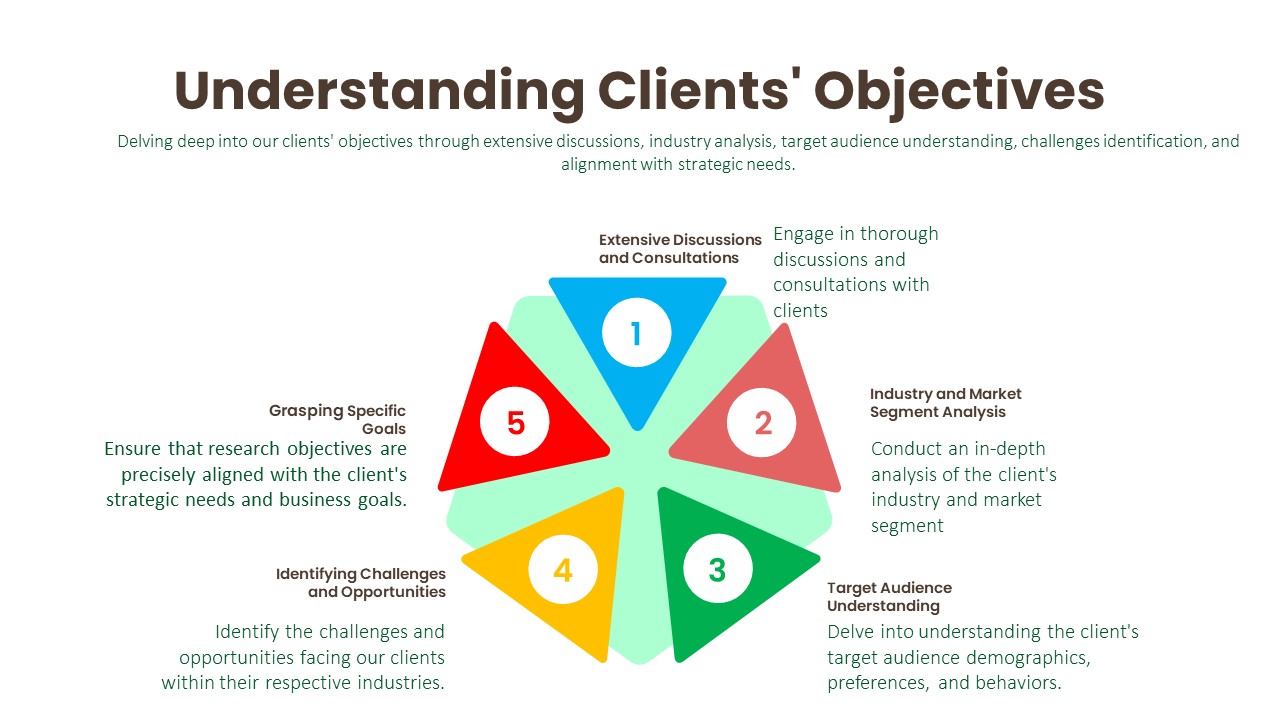
Identifying Challenges and Opportunities:
- We proactively identify the challenges and opportunities facing our clients within their respective industries. This involves conducting SWOT (Strengths, Weaknesses, Opportunities, Threats) analyses and competitive benchmarking exercises.
- By identifying potential obstacles and growth drivers, we can provide strategic recommendations that help our clients navigate complexities and capitalize on emerging opportunities effectively.
Grasping Specific Goals:
- We delve into the intricacies of our clients’ objectives to gain clarity on the specific goals they aim to accomplish through the research. This entails understanding their desired outcomes, such as market expansion, product development, or competitive analysis.
- By gaining a nuanced understanding of our clients’ goals, we can tailor our research approach to address their unique challenges and opportunities effectively.
Data Collection:
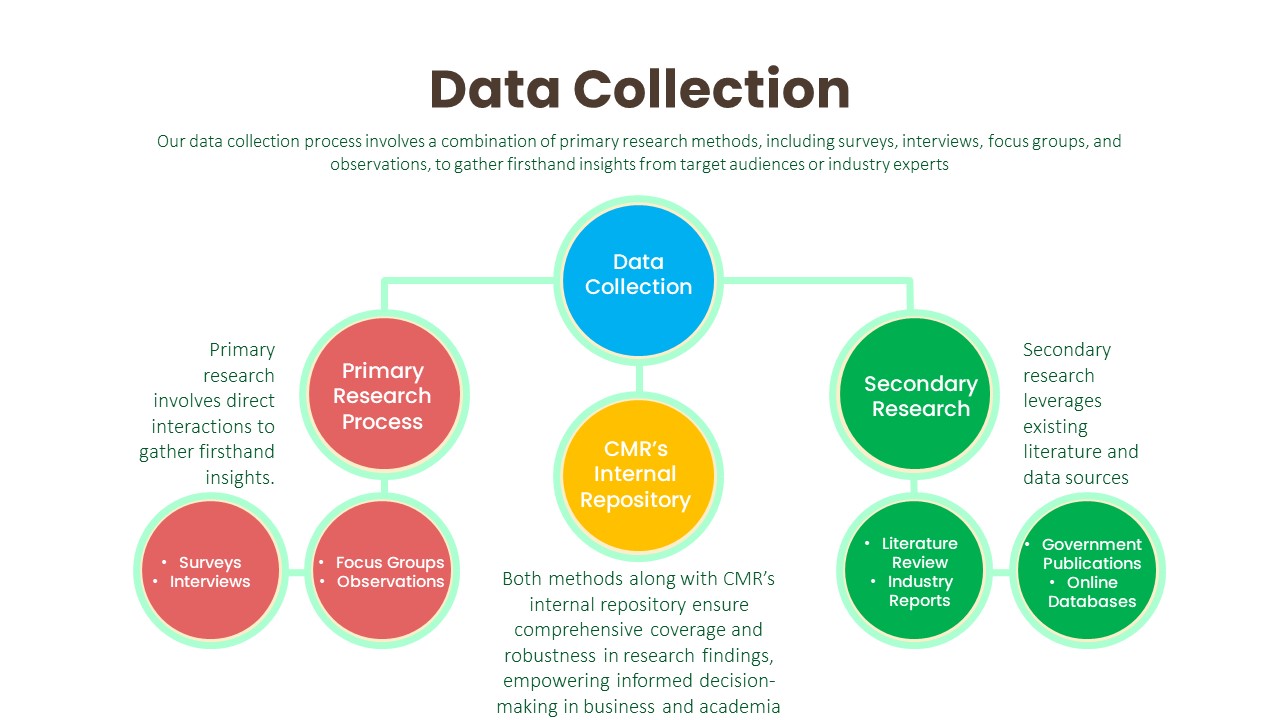
Primary Research Process:
- Surveys: We design and administer surveys tailored to capture specific information relevant to our clients’ objectives. This may involve employing various survey methodologies, such as online, telephone, or face-to-face interviews, to reach target audiences effectively.
- Interviews: We conduct structured or semi-structured interviews with key stakeholders, industry experts, or target consumers to gather in-depth insights and perspectives on relevant topics. These interviews allow us to probe deeper into specific issues and uncover valuable qualitative data.
- Focus Groups: We organize focus group discussions with carefully selected participants to facilitate interactive discussions and gather collective opinions, attitudes, and preferences. This qualitative research method provides rich contextual insights into consumer behaviors and perceptions.
- Observations: We conduct observational research by directly observing consumer behaviors, interactions, and experiences in real-world settings. This method enables us to gather objective data on consumer actions and reactions without relying on self-reported information.
Secondary Research Process:
- Literature Review: We conduct comprehensive literature reviews to identify existing studies, academic articles, and industry reports relevant to the research topic. This helps us gain insights into previous research findings, theoretical frameworks, and best practices.
- Industry Reports: We analyze industry reports published by reputable trade associations (whitepapers, research studies, etc.), and government agencies (U.S. Census Bureau, Bureau of Labor Statistics, and Securities and Exchange Commission etc.) to obtain macro-level insights into market trends, competitive landscapes, and industry dynamics.
- Government Publications: We review government publications, such as economic reports, regulatory documents, and statistical databases, to gather relevant data on demographics, market size, consumer spending patterns, and regulatory frameworks.
- Online Databases: We leverage online databases, such as industry portals, and academic repositories (PubMed Central (PMC), ScienceDirect, SSRN (Social Science Research Network), Directory of Open Access Journals (DOAJ), NCBI, etc.), to access a wide range of secondary data sources, including market statistics, financial data, and industry analyses.
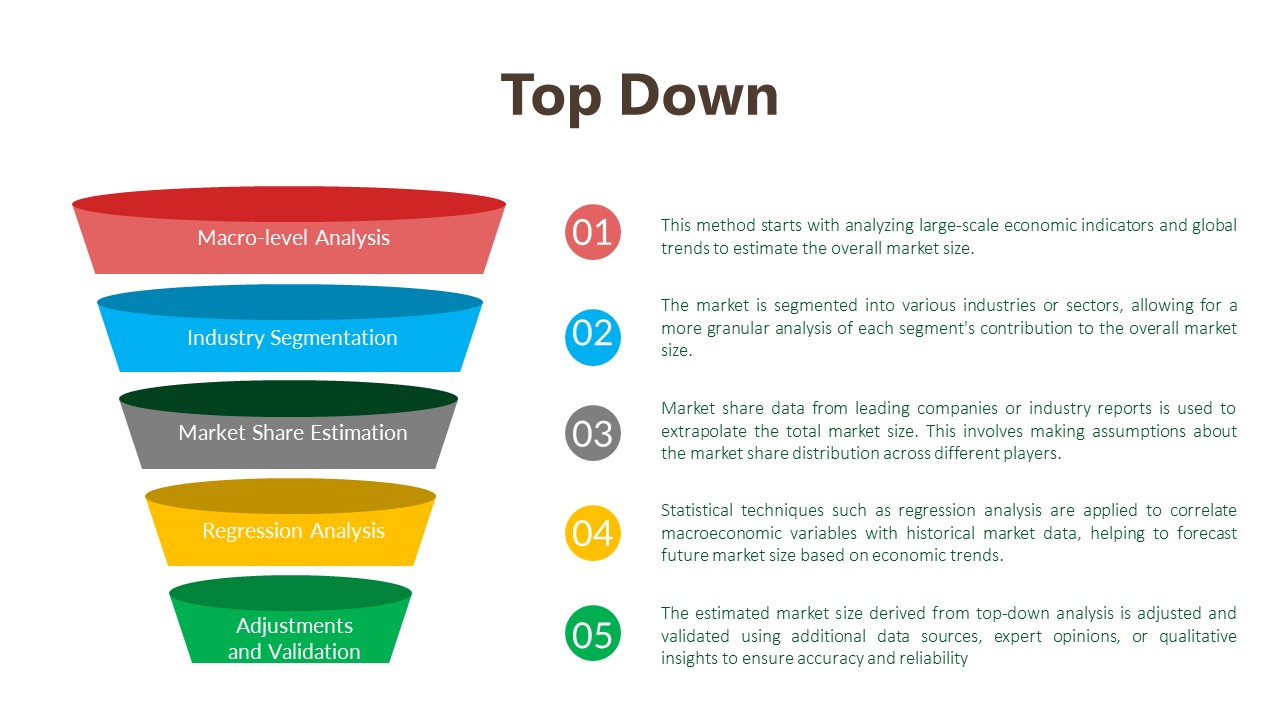
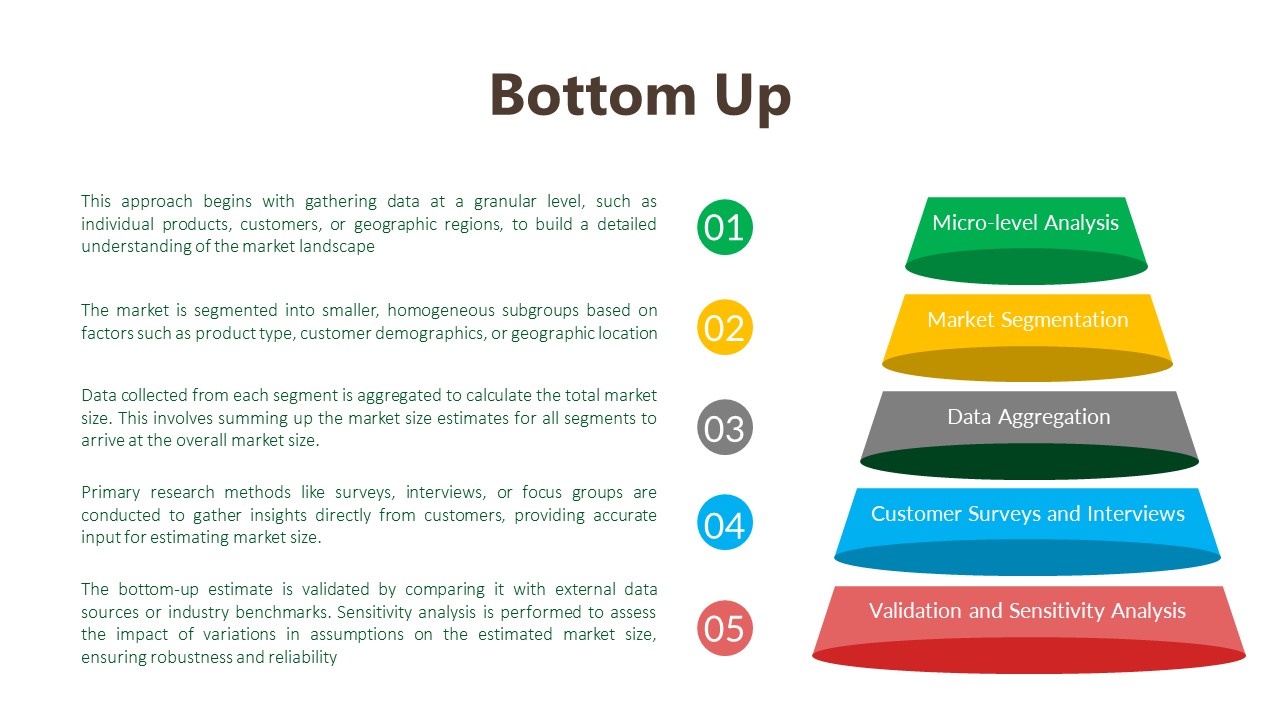
Data Analysis:
The data analysis phase serves as a critical juncture where raw data is transformed into actionable insights that inform strategic decision-making. Through the utilization of analytical methods such as statistical analysis and qualitative techniques like thematic coding, we uncover patterns, correlations, and trends within the data. By ensuring the integrity and validity of our findings, we strive to provide clients with accurate and reliable insights that accurately reflect the realities of the market landscape.

Transformation of Raw Data:
- Upon collecting the necessary data, we transition into the data analysis phase, where raw data is processed and transformed into actionable insights. This involves organizing, cleaning, and structuring the data to prepare it for analysis.
Utilization of Analytical Methods:
- Depending on the research objectives, we employ a diverse range of analytical methods to extract meaningful insights from the data. These methods include statistical analysis, trend analysis, regression analysis, and qualitative coding.
Statistical Analysis:
- Statistical tools are instrumental in uncovering patterns, correlations, and trends within the data. By applying statistical techniques such as descriptive statistics, hypothesis testing, and multivariate analysis, we can discern relationships and derive valuable insights.
Qualitative Analysis Techniques:
- In addition to quantitative analysis, we leverage qualitative analysis techniques to gain deeper insights from qualitative data sources such as interviews or open-ended survey responses. One such technique is thematic coding, which involves systematically categorizing and interpreting themes or patterns within qualitative data.
Integrity and Validity Maintenance:
- Throughout the analysis process, we maintain a steadfast commitment to upholding the integrity and validity of our findings. This entails rigorous adherence to established methodologies, transparency in data handling, and thorough validation of analytical outcomes.
Data Validation:
The final phase of our research methodology is data validation, which is essential for ensuring the reliability and credibility of our findings. Validation involves scrutinizing the collected data to identify any inconsistencies, errors, or biases that may have crept in during the research process. We employ various validation techniques, including cross-referencing data from multiple sources, conducting validity checks on survey instruments, and seeking feedback from independent experts or peer reviewers. Additionally, we leverage internal quality assurance protocols to verify the accuracy and integrity of our analysis. By subjecting our findings to rigorous validation procedures, we instill confidence in our clients that the insights they receive are robust, reliable, and trustworthy.
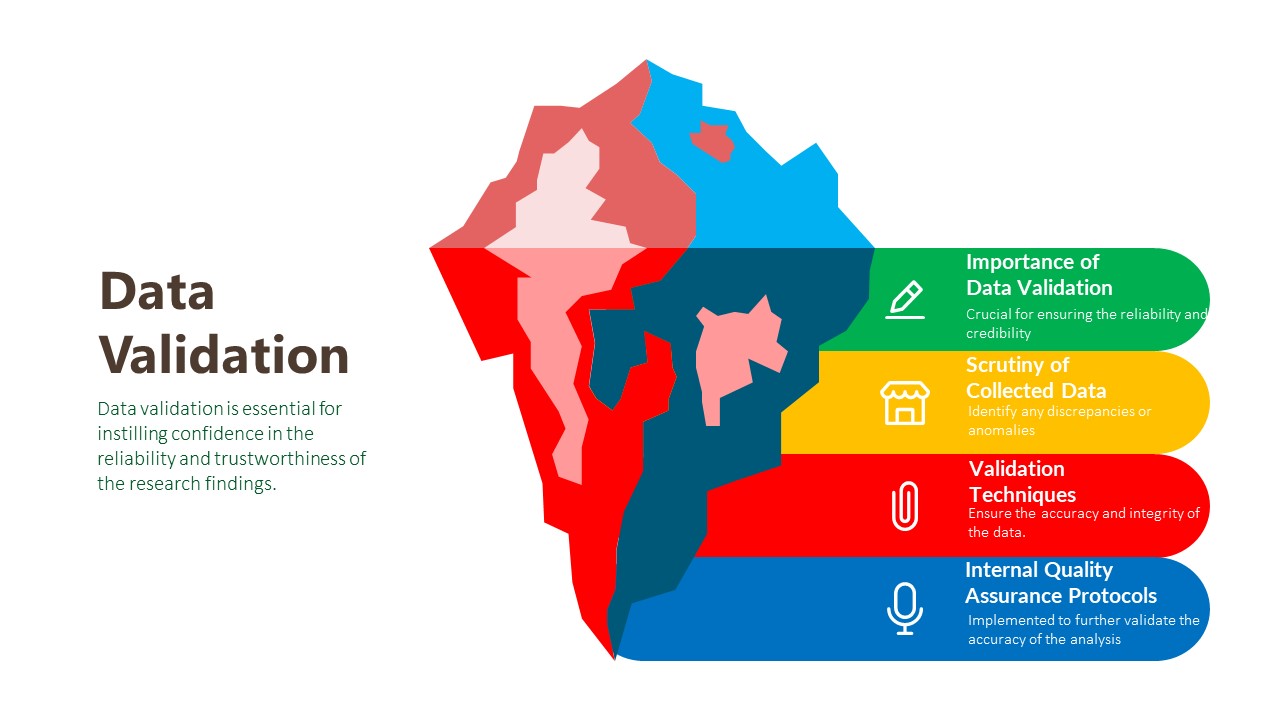
Importance of Data Validation:
- Data validation is the final phase of the research methodology, crucial for ensuring the reliability and credibility of the findings. It involves a systematic process of reviewing and verifying the collected data to detect any inconsistencies, errors, or biases.
Scrutiny of Collected Data:
- The validation process begins with a thorough scrutiny of the collected data to identify any discrepancies or anomalies. This entails comparing data points, checking for outliers, and verifying the accuracy of data entries against the original sources.
Validation Techniques:
- Various validation techniques are employed to ensure the accuracy and integrity of the data. These include cross-referencing data from multiple sources to corroborate findings, conducting validity checks on survey instruments to assess the reliability of responses, and seeking feedback from independent experts or peer reviewers to validate the interpretation of results.
Internal Quality Assurance Protocols:
- In addition to external validation measures, internal quality assurance protocols are implemented to further validate the accuracy of the analysis. This may involve conducting internal audits, peer reviews, or data validation checks to ensure that the research process adheres to established standards and guidelines.
We can customize every report – free of charge – including purchasing stand-alone sections or country-level reports
We help clients to procure the report or sections of the report at their budgeted price. Kindly click on the below to avail



